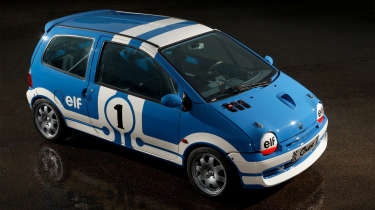Renault Twingo Coupé – dead on arrival
A first-generation Twingo, stripped-out and powered by a 150bhp Clio Williams engine? If only…

In the early 1970s Renault initiated projet VBG (‘Véhicule Bas de Gamme’ or ‘Low Range Vehicle’) with the aim of making a low-cost people’s car. This morphed, via some zany schemes involving round side windows, reversible passenger seats and on-board bean-bag chairs, into a small, functional three-door hatchback that reached the running prototype stage before being cancelled at the dawn of the ’80s. Undeterred, Renault spent the following years making multiple doomed attempts to get a cheap, entry-level model across the line and every time these projects failed for the same reason: a firm ‘non’ from le department d’accountancy.
To get a new people’s car into production Renault’s engineers had to be ingenious, and that’s exactly what they were with X06, the project that became the original Twingo. Even its name – a portmanteau of twist, swing and tango – was clever. The real cleverness, however, was in and around its bold monobox skin. To ensure the Twingo was quick and cheap to build it had cunning features like upholstery glued directly to the seat foam and a radio aerial mounted on the door mirror rather than the roof to save a few centimes in wiring, and to keep things simple on the production line the car was launched with just one trim level and four paint colours. The Twingo was a masterclass in cost-effective industrial design and Renault later used many of the lessons learnt in creating the modern-day Dacia range.
The quest for simplification also extended to engine choice, or lack of it, because initially the Twingo came with a 1.2-litre four-cylinder – a modernised version of the old Cléon-Fonte motor first used in the 1960s – and that was it. Designing the car around this lone motor meant everything could be optimised to its modest 54 horsepower output, creating a virtuous circle in which suspension and braking systems could be simpler and therefore cheaper, safe in the knowledge they wouldn’t have to handle greater power outputs.
Unfortunately, this seemed to rule out the prospect of a hotter variant to rival the Fiat Cinquecento Sporting. But Renault motorsport boss Christian Contzen wasn’t so sure and a couple of years into the car’s life he began dreaming of an affordable one-model race series using the Twingo, predicated on being able to put some more pep in its step. To that end, Contzen’s team squeezed a 1.6-litre four from a Mégane under the stubby bonnet, tuned to give a sizzling 135 horsepower. But apparently this wasn’t enough and in 1995 they went further with the fabulous machine you see here: a stripped-out, caged-up Twingo painted like an old Gordini rally car and running the 2-litre, 150bhp F7R engine from a Clio Williams. It was called the Twingo Coupé, in this case ‘coupé’ meaning ‘cup’, and as you can see, with its additional bonnet intake and the same Speedline alloys as the Clio Williams, it looked sensational.
Sadly it was not to be. Cramming a larger powertrain into a car never designed to take it created issues with NVH and the turning circle that would have been hard to resolve, never mind all the bespoke parts the Coupé would have required and the expense that would have entailed, contra to the Twingo ethos. Sad to say, the Coupé really was dead on arrival. But at least Renault kept this experiment tucked away for posterity, and every once in a while – such as at the Twingo’s 30th birthday celebrations at the Retromobile show in Paris earlier this year – shares it with the public so we can see what might have been.



